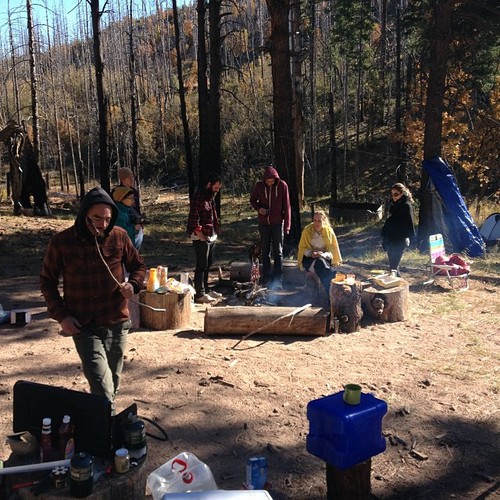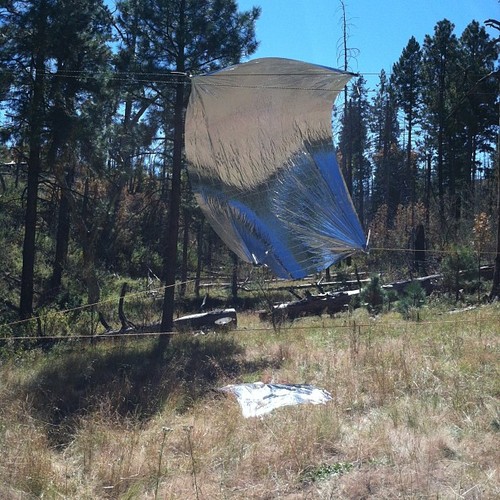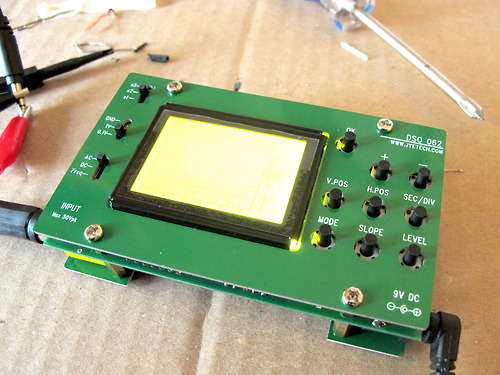Over the past week, three artists have been camping out in Arizona in search of paranormal activity. This trio (Daniel J. Glendening, Michael Welsh, and Sean Joseph Patrick Carney, collectively known as the GWC, Investigators) came well-prepared, their backpacks loaded with homemade UFO-hunting equipment, and a full set of plans. As part of High Desert Test Sites, a program run by Andrea Zittel in New Mexico, their eyes were set on exploring well-known alien abduction sites, and interviewing residents who’ve seen signs of extraterrestrial life. The three artists have produced videos, sculptures, books, and performances together, but this is their first under the GWC moniker.
I wanted to find out more, because I’ve had an interest in that crossover of art and sci-fi for some time. I’m pretty sure I’m not the only one; when contemporary art—and Land Art in particular—happens in the desert, there’s often an air of the paranormal. Robert Smithson devoured science fiction paperbacks (his term “Earthworks” comes directly from Brian Aldiss’s dystopian novel of the same name), and he passed away before seeing through his plan for a UFO documentary. Marfa, Texas, home to the Judd Foundation, is a spooky, deserted town, perhaps better-known in popular culture for the “Marfa Ghost Lights.” Visitors to Walter De Maria’s “The Lightning Field” describe it as just plain spooky, and sometimes mystical. GWC Investigators seem to be playing into that history, but you can never really know, so I set up a time to chat with them over email—there’s no cell phone reception at their campsite—to get a report about what they’re doing out in the middle of nowhere.
How do you explain this project as art?
While we’re conducting paranormal research, we’re also looking at UFO experiences with the unique perspective of artists. Meaning, we’re evaluating the aesthetics of these experiences and the geographical region in a way that a traditional paranormal research team would not. Our interest isn’t in proving or disproving UFO experiences, but is rather rooted in a fascination with the history and mythology surrounding this particular site, and how we as artists can translate that into visual work experienced by viewers who won’t ever visit this site.
Our camp itself is spread out across the clearing where Walton was abducted; we’re all doing our own art practices at the camp daily, and doing collective pieces. Daniel built a pretty amazing solar panel and battery piece that we’ve been using to charge our various devices throughout the week.
One of the collective works that we did on the first night was using a laptop and digital projector to project the film Fire in the Sky into the actual clearing where the abduction happened. Viewing the [cinematic] translation of this experience at the real site was a kind of performance that we designed. It also severely freaked us all out.
You guys are camping?
Yes. Our base camp GPS coordinates are 34.302252, -110.642982 near Turkey Springs, AZ in the Sitgreaves National Forest. The location of our camp is very significant because it is the site of Travis Walton’s abduction in early November of 1975. Walton’s story is the subject of the film Fire in the Sky, which is based on a book that he wrote about his abduction, The Walton Experience.
We’ve been there for four nights, and tonight [Thursday] is our last night at camp. Several people who are doing the High Desert Test Sites drive from Joshua Tree, CA to Albuquerque, NM are coming out tonight to participate in a public UFO watch that we’re hosting.
What does it look like out there?
Although we’re in Arizona, we’re actually in a forest as opposed to the desert. It gets extremely cold here at night, and we’re at about 6,000 feet elevation. There is a lot of evidence of forest fires in the past, so it’s kind of surreal-looking out here.
Here is a photo of Daniel’s notes of the clearing:
How did the three of you come together to do this?
We started working on this idea probably 15 months ago, and then we heard that High Desert Test Sites was accepting project proposals for the first time in their history. GWC, Investigators will be an ongoing project that examines the aesthetics of multiple realms of paranormal activity, not just UFOs. But for HDTS 2013, we created a very focused project that used the Walton abduction as its central focus. There are many other areas of the world where we’d love to do our research and we’ve been making lists of future endeavors all week.
Does this project have anything to do with The X-Files?
Um, we love The X-Files. This project is certainly influenced by that television program. We created a poster edition of 100 for this project that is a play on Mulder’s poster in his office on the show.
What did you guys pack with you?
We have all of the traditional camping gear, but on top of that we brought along several items that are related to our field work:
Video cameras
Solar panel battery setup
H2 Zoom Audio Recorder
Dyeing kits (for making tie-dye flags, etc.)
Obsidian wards (necklaces Daniel made us for protection)
Gaussmeter with modded input and two antennae (standard amplification antennae and one experimental quartz & copper antennae)
Oscilloscope
Altimeter
Compass
Topo maps of the area
Did you guys build instruments to bring out into the field? How did you find out what to make?
Daniel built several machines, including the solar power station used for charging and powering tools and equipment, a modified Gaussmeter used for measuring electromagnetic fields (EMF) and two antennae for use with the Gaussmeter, an oscilloscope for a visual representation of EMF fields. Gaussmeters are a common tool often used by electricians, et cetera, but paranormal investigators have appropriated the tool for measuring EMF fields associated with ghost sightings and UFO phenomenon.
Can you give me an example of some of the questions you’re asking UFO believers?
Michael produced a really intensive interview questionnaire that we’ve been using. We also all took the interview ourselves last night, and we’ll be giving it to the people who come out tonight [to the UFO watch]. It’s very long, and takes roughly 30 minutes to complete in full. Here are a couple examples of questions:
Have you experienced disaster dreams, earth changes, and earthquakes? Y / N
Have you experienced memories that seem like they have not actually happened? Y / N
Have you experienced memories or dreams that feel as if they have happened to another person or foreign being? Y / N
Do you watch professional sports on television? Y/N
Are you a fan of the science fiction genre in film or literature? Y / N
Do you see street lights burn out often, see lights dim when you enter a room, or experience other electronic anomalies? Y / N
Do you take medication for this sleep disorder? Y / N
How did you find UFO believers? Do they just hang out in the town? Does everyone believe in them?
It’s a mixed bag, to be honest. It seems like people in this area of the country are generally more open to ideas about UFO experiences, likely because of the higher-than-average number of experiences reported here. In terms of the Walton case, specifically, we’ve found it interesting that it’s just so matter of fact here. People don’t seem weirded out by it, and the town of Snowflake where he lives (and lived at the time) is very small. Many people that we met and talked to there know him personally. We have learned very quickly that we have to organically feel out every interaction to decide when it’s appropriate to explain what we’re doing, and also how much information to give out.
The majority of people that we’ve met here have been really forthcoming and actually super interested in the project, but there are also a lot of people out here who are less, well, wholesome. Nobody here knows that we’re camping at the Walton abduction site.
Following their week of camping, GWC, Investigators wrapped up by delivering a talk on their findings at the University of New Mexico’s Tamarind Institute. Future plans for the GWC, Investigators include a documentary film and an artist’s book featuring their daily journals and field notes.








Comments on this entry are closed.